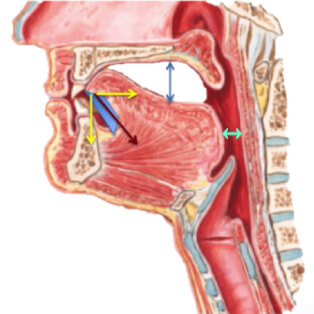



The back of the tongue should be resting high up on the palate. This helps in keeping the airway wide open. If the tongue is resting low it, the posterior part of the tongue falls back and can narrow the airway, contributing to mouth breathing, noisy breathing, snoring or blocking the airway completely causing sleep apnea
Want to know if you have a tongue tie? Follow our 6-step assessment to determine if you have a tongue tie.Schedule a consultation with our experienced team to discuss your options and improve your quality of life.
FUNCTIONAL CLASSIFICATION OF ANKYLOGLOSSIA BASED ON TONGUE RANGE MOTION RATIO (TRMR)





1) Soroush Zaghi, Sanda Valcu‐Pinkerton, Mia Jabara, Leyli Norouz‐Knutsen, Chirag Govardhan, Joy Moeller, Valerie Sinkus, Rebecca S. Thorsen, Virginia Downing, Macario Camacho, Audrey Yoon, William M. Hang, Brian Hockel, Christian Guilleminault, Stanley Yung‐Chuan Liu. Lingual frenuloplasty with myofunctional therapy: Exploring safety and efficacy in 348 cases. Laryngoscope Investig Otolaryngol. 2019 Oct; 4(5): 489–496.
2) A. J. Yoon, S. Zaghi, S. Ha, C. S. Law, C. Guilleminault, S. Y. Liu. Ankyloglossia as a risk factor for maxillary hypoplasia and soft palate elongation: A functional – morphological study. Orthod Craniofac Res. 2017;1–8.
3) So-Jeong Jang, Bong-Kuen Cha, Peter Ngan, Dong-Soon Choi, Suk-Keun Lee, Insan Jang. Relationship between the lingual frenulum and craniofacial morphology in adults. American Journal of Orthodontics and Dentofacial Orthopedics. April 2011;139:4(1)
4) Audrey Yoon; Soroush Zaghi; Rachel Weitzman; Sandy Ha; Clarice S. Law; Christian Guilleminault; Stanley Y.C. Liu. Towards a Functional Definition of Ankyloglossia: Validating Current Grading Scales for Lingual Frenulum Length and Tongue Mobility in 1052 Subjects Sleep And Breathing.January 2017;21(3)
Please feel free to Contact Us.
Copyright ©2025 TMJ, Tongue Tie and Sleep Institute. All Rights Reserved.
WhatsApp us
Let Us Know How Can We Help You!
At our institute, we take pride in providing complete care for issues related to tongue tie and TMJ. To enhance your quality of life, we treat a range of ailments with state-of-the-art technology and expert care. If you’re searching for an effective tongue-tie operation option or a TMJ specialist in India, you have arrived at the right place.
A tongue tie operation or tongue tie surgery is a life-changing procedure that not only restores tongue mobility but also has a full body effect. While most people associate tongue tie with breastfeeding difficulties in infants, it can also affect speech, breathing, posture, dental health, and sleep patterns in older children and adults. By undergoing this minimally invasive fascia release procedure, patients often experience immediate improvements in functionality and overall well-being.
For individuals considering tongue tie surgery, the benefits are far-reaching:
The Temporomandibular Joint (TMJ) that is your Jaw Joint has a significant impact on one’s quality of life, as they leave the person feeling exhausted and irritable. It not only affects essential functions like chewing, speaking, yawning but also affects one’s posture, breathing and sleep. As a leading TMJ specialist in Mumbai, we offer comprehensive diagnostics and personalized treatment plans to address your unique needs.
An integral part of our treatment protocols is myofunctional therapy. Exercises used in this therapy help to strengthen and coordinate the muscles of the tongue and face. Whether you’re undergoing a tongue tie operation or being treated for TMJ issues, myofunctional therapy plays a pivotal role in ensuring lasting outcomes.
Expertise and complete treatment are essential for treating TMJ issues or tongue tie. Whether you’re searching for the best tongue tie surgery options or a trusted TMJ specialist in Mumbai, we ensure personalized care and transformative results. Don’t let these conditions stop you—reach out to us today to book your consultation and start your journey toward better health and wellness.